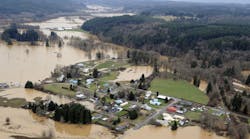As Earth’s weather patterns shift, new challenges have arisen for those tasked with keeping basic utilities running reliably. Although they may not be large spectacles on the evening news, some of climate change’s subtler effects have the same potential for real catastrophe.
These challenges often go unnoticed by the general public but, to those who work on the front lines, the need to harden infrastructure remains constant and urgent. One such potentially catastrophic event occurs in lakes and reservoirs around the world: harmful algal blooms (HABs).
In 2018, this was precisely the scenario at Detroit Lake, which serves as the main source of drinking water for the City of Salem, Ore. With little warning, the levels of cyanotoxins spiked.
Officials raced to ascertain the scope of the problem. While some HABs are just a nuisance, tainting drinking water with a musty taste or smell, those that produce cyanotoxins pose serious health risks to humans and animals. Local news media ran a story on the cyanotoxin levels, which officials worried might drive public panic.
When the dust settled, officials identified a need for better predictive modeling, which would allow them to adjust processes quickly in response to real water conditions.
While the City of Salem’s Public Works Department (PWD) had already adopted machine learning and other digital technologies to make its operations more efficient, at the time of the 2018 HAB event, it had yet to use its data management platform to predict cyanotoxin spikes.
New Models for the Future
In 2016, the City of Salem installed an operations data management platform to help make its water and wastewater operations more efficient. The AVEVA Process Information (PI) System delivered real-time data to team members via the cloud, helping users visualize their processes and act proactively.
As the City of Salem further digitized its assets, it partnered with Casne Engineering to build out an asset framework for its PI system, hoping that the predictive asset maintenance could lead to significant reductions in overall energy consumption. Salem achieved many gains in operational efficiency as a result — but, to combat harmful algal blooms, the city needed the ability to predict and react quickly to new threats.
The city needed to know when an HAB event might happen again. With advanced warning, the PWD could make operational changes to address the presence of harmful cyanotoxins before they become a public health concern.
“We ultimately wanted to predict when harmful algal blooms were going to be present in our reservoir,” said Devin Doring, technical services supervisor for the Salem Public Works Department. “If we could predict that, we’d have time to adjust our processes.”
Doring and his teammates set a clear goal that utilized the PI system’s central data hub to make real-time data accessible from any location.
The Predictive Analytics Solution
Predictive modeling is one of the best tools available in the field of climate science. It has been used for years to follow ocean currents and temperatures, extreme weather events, and the enduring drought in the Western United States. Scientists have only recently applied predictive models to monitor water quality in freshwater supplies.
As Doring and his team strategized ways to use technology to predict the next HAB in Detroit Lake, they contacted researchers at Oregon State University who specialized in advanced predictive models.
The City of Salem decided to invest in a wider set of data resources to reach its goal, integrating advanced modeling algorithms into its existing PI System. Doring and his team incorporated weather data from the National Oceanic and Atmospheric Administration and the US Geological Survey, as well as satellite imagery and data from water quality monitoring equipment attached to pontoon floats. In its current iteration, the updated system also integrates data from laboratory analysis and the SCADA control system.
Building Trust and Ensuring Quality
Aided by its operations data platform, the City of Salem created a highly integrated system that — given the multiplicity of data points from both the natural and built environment — offers optimal monitoring of water quality at the Detroit Lake site.
To raise awareness and foster public trust after the 2018 cyanotoxin scare, the City of Salem now regularly publishes modeling data for public use with a predictive lead time of one week. Salem’s PWD plans to continue honing its modeling algorithms, with the hope of increasing the predictive lead time to a month or more.
As climate change creates uncertainty and new challenges in the water and wastewater industries, it’s more imperative than ever that enterprises improve their resilience, agility, and operational efficiency, so that they’re best prepared to meet the challenges and opportunities of the future. SW
Gary Wong is the Global Industry Principal of Infrastructure and Water at AVEVA. He leads their global data centers, facilities, smart cities and water businesses. Wong is also the Chairman of the Smart Water Networks Forum (SWAN) Americas Alliance.
Published in Stormwater magazine, February 2022.
About the Author
Gary Wong
Gary Wong is the Global Industry Principal of Infrastructure and Water at AVEVA. He leads their global data centers, facilities, smart cities and water businesses. Wong is also the Chairman of the Smart Water Networks Forum (SWAN) Americas Alliance.



